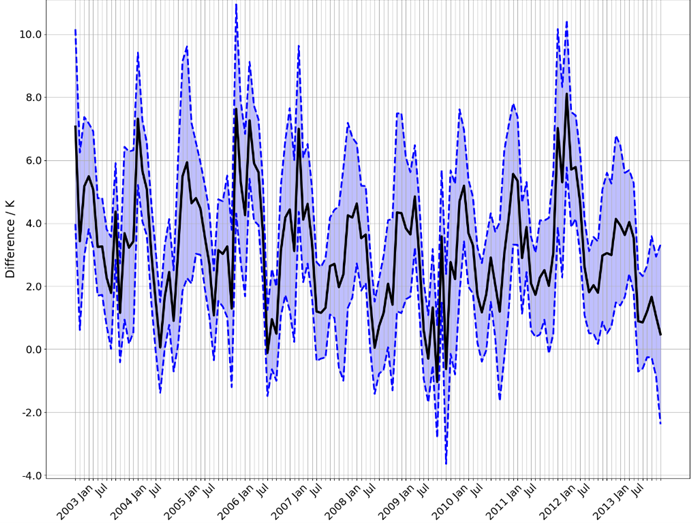ESA CCI Land Surface Temperature data are used to assess CMIP6 models using a new ESMValTool diagnostic
Key Highlight
A tool has been developed to allow the use of ESA CCI Land Surface Temperature (LST) data for assessment of CMIP6 models
- ESMValTool can now be used to compare LST simulations from CMIP6 models with ESA CCI LST data, allowing identification of systematic differences between simulations and observations (model biases). This allows improved understanding and interpretation of the models and aids future model development.
Motivation
The World Climate Research Programme (WCRP) Coupled Model Intercomparison Project (CMIP) is a collaborative framework designed to improve knowledge of climate change through comparison of state-of-the-art climate models. A thorough assessment of the models' skill in reproducing observations of past and present climate is essential to assess and interpret the results from model projections (Eyring et al., 2019; Lauer et al.,2020). CMIP6[1] is the latest phase of the project, it is made up of 23 Model Intercomparison Projects (MIPs) involving more than 40 modelling groups around the world.
Comparison with observations is useful for evaluation of the models used in CMIP6 and the CCI ECV datasets are well placed being of long duration, consistent and made available on the Earth System Grid Federation (ESGF) which is the standard output for CMIP6 models. This allows an informed interpretation of projections from each model and provides information for model improvements.
Model output consists of a large range of physical parameters describing the Earth System (atmosphere, ocean, land surface, cryosphere) which can be considered in a number of different ways (e.g. averages over time, averages over space, time series), so the options for comparison are numerous. ESMValTool[2] allows different model/observation comparisons to be carried out, generating a variety of statistics, or diagnostics, for a range of physical parameters. The range of available diagnostics is being extended by CMUG to include comparisons with as many CCI ECV datasets as possible, and this briefing note describes one such development.
Results
A diagnostic for ESMValTool has been developed to utilise the ESA CCI LST data. This diagnostic can be used to compare any CMIP6 models with the monthly average Aqua MODIS LST dataset. The region of interest can be adjusted to investigate specific regions or biomes. This diagnostic can be used to assess the CMIP6 models, looking at, among other things, bias; seasonal variations; and El Niño events as illustrated in Figure 1, which shows the ESMValTool diagnostic compared to a historical ensemble mean from one of the CMIP6 models (UKESM).
The systematic difference between the model output and the observations is known as model bias (assuming the observations are truth) and can be used to highlight areas where model improvements can be made. Figure 1 shows the difference between CCI LST and UKESM LST is generally positive, meaning UKESM simulated LSTs colder than observations, indicating a negative bias in the model. This information is useful for model development and interpreting its climate change projections.
Seasonal variations and El Nino events are apparent in the differences between observations and model. In Figure 1 it is clear that seasonally the differences are larger in NH winter (4-8 K) and smaller in NH summer (0-2 K) and that difference becoming smaller and at times slightly negative during an El Nino year. This is also helpful information for model developers who can investigate the underlying reasons for the differences and thus improve the model.
[1] https://pcmdi.llnl.gov/CMIP6/Guide/dataUsers.html
[2] https://www.esmvaltool.org/about.html


References
Eyring, V., Cox, P. M., Flato, G. M., Gleckler, P. J., Abramowitz, G., Caldwell, P., Collins, W. D., Gier, B. K., Hall, A. D., Hoffman, F. M., Hurtt, G. C., Jahn, A., Jones, C. D., Klein, S. A., Krasting, J. P., Kwiatkowski, L., Lorenz, R., Maloney, E., Meehl, G. A., Pendergrass, A. G., Pincus, R., Ruane, A. C., Russell, J. L., Sanderson, B. M., Santer, B. D., Sherwood, S. C., Simpson, I. R., Stouffer, R. J. & Williamson, M. S. (2019) Taking climate model evaluation to the next level. Nature Climate Change. doi:10.1038/s41558-018-0355-y. https://www.nature.com/articles/s41558-018-0355-y
Lauer, A., Eyring, V., Bellprat, O., Bock, L., Gier, B. K., Hunter, A., Lorenz, R., Pérez-Zanón, N., Righi, M., Schlund, M., Senftleben, D., Weigel, K., and Zechlau, S.: Earth System Model Evaluation Tool (ESMValTool) v2.0 - diagnostics for emergent constraints and future projections from Earth system models in CMIP, GMD, 13, 4205-4228, https://gmd.copernicus.org/articles/13/4205/2020/, 2020.
About the author

This article was produced in 2022 by Rob King at the Met Office.

